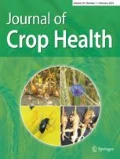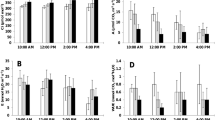Abstract
A semi-closed greenhouse was used for sustainable tomato production and to investigate the effects of the prevailing climate conditions within this greenhouse on different plant parameters of tomatoes. Compared to conventionally cultivated tomato plants, the leaf area index, the number of trusses and the yield of marketable fruit of tomato plants exposed to the microclimatic conditions in the semi-closed greenhouse were significantly increased by 21, 11 and 31.9 %, respectively. Furthermore, the application of this new technology led to a significant increase in contents of lycopene (by 30 %), ß-carotene (by 40 %), phenolic compounds (25 %), titratable acids (by 8 %) and soluble solids (by 15 %) in tomatoes during the summer period. These results were attributed to higher photosynthetic activities, which predominantly occurred in the greenhouse with the semi-closed operation mode. Furthermore, the new technology can be seen as new horticultural approach to reduce the yield of blossom-end rot fruit by 75.2 %. This quality improvement was caused by higher levels of relative humidity, where this humidity states were also responsible for a reduction in the annual plant transpiration rate by 10 %.
Zusammenfassung
Tomaten wurden in einem semi-geschlossenen Gewächshaus im Vergleich zu einem konventionellen Gewächshaus produziert und die Auswirkungen der vorherrschenden Klimabedingungen in den Gewächshäusern auf verschiedene Pflanzenparameter untersucht. Im Vergleich zu konventionell kultivierten Tomatenpflanzen waren der Blattflächenindex (um 21 %), die Anzahl der Rispen (um 11 %) und der Ertrag der vermarktungsfähigen Früchte (um 31.9 %) der Tomatenpflanzen, die den mikroklimatischen Bedingungen im semi-geschlossenen Gewächshaus ausgesetzt waren, signifikant erhöht. Darüber hinaus führte die Applikation dieser neuen Technologie in den Sommermonaten zu einer signifikanten Erhöhung der Gehalte von Lykopin (um 30 %), ß-Carotin (um 40 %), phenolischen Verbindungen (um 25 %), titrierbaren Säuren (um 8 %) und löslicher Trockensubstanz (um 15 %) in Tomaten. Diese Ergebnisse wurden auf höhere photosynthetische Aktivitäten zurückgeführt, die überwiegend im Gewächshaus mit semi-geschlossenem Betriebsmodus auftraten. Weiterhin kann die neue Technologie als gartenbaulicher Ansatz gesehen werden, um den Ertrag der mit Blütenendfäule befallenden Früchte um 75,2 % zu reduzieren. Diese Qualitätsverbesserung wurde durch das höhere Niveau der relativen Luftfeuchtigkeit hervorgerufen, wobei diese Feuchtezustände auch für die Reduzierung der jährlichen Transpirationsrate um 10 % verantwortlich war.






Similar content being viewed by others
References
Adams SR, Cockshull KE, Cave CRJ (2001) Effect of temperature on the growth and development of tomato fruits. Ann Bot 88:869–877
Armstrong MJ, Kirkby EA (1979) Influence of humidity on the mineral-composition of tomato plants with special reference to calcium distribution. Plant Soil 52:427–435
ASU-L-26.11.03–4 (1983) Determination of the total acid content in tomato concentrate (potentiometric method). BVL
Auerswald H, Schwarz D, Kornelson C, Krumbein A, Bruckner B (1999) Sensory analysis, sugar and acid content of tomato at different EC values of the nutrient solution. Sci Hortic 82:227–242
Bagchi DB, Sen CK, Ray SD, Das DK, Bagchi M, Preuss HG, Vinson JA (2003) Molecular mechanisms of cardioprotection by a novel grape seed proanthocyanidin extract. Mutation Research 523:87–97
Bazzano LA, He J, Ogden LG, Loria CM, Vupputuri S, Myers L, Whelton PK (2002) Fruit and vegetable intake and risk of cardiovascular disease in US adults: the first National Health and Nutrition Examination Survey Epidemiologic Follow-up Study. Am J Clin Nutr 76:93–99
Bertin N, Guichard S, Leonardi C, Longuenesse JJ, Langlois D, Navez B (2000) Seasonal evolution of the quality of fresh glasshouse tomatoes under Mediterranean conditions, as affected by air vapour pressure deficit and plant fruit. load Ann Bot 85:741–750
Campen JB, Bot GPA (2002) Dehumidification in greenhouses by condensation on finned pipes. Biosystems Eng 82:177–185
Connor AM, Luby JJ, Tong CBS (2002) Variability in antioxidant activity in blueberry and correlations among different antioxidant activity assays. J Am Soc Hortic Sci 127:238–244
Dannehl D, Huyskens-Keil S, Eichholz I, Ulrichs C, Schmidt U (2011) Effects of direct-electric-current on secondary plant compounds and antioxidant activity in harvested tomato fruits (Solanum lycopersicon L.). Food Chem 126:157–165
Dannehl D, Rocksch T, Schmidt U (2014a) Modelling to estimate the specific leaf area of tomato leaves (cv. Pannovy). Acta Hort: in press
Dannehl D, Suhl J, Huyskens-Keil S, Ulrichs C, Schmidt U (2014b) Effects of a special solar collector greenhouse on water balance, fruit quantity and fruit quality of tomatoes. Agric Water Manage 134:14–23
De Gelder A, Dieleman JA, Bot GPA, Marcelis LFM (2012) An overview of climate and crop yield in closed greenhouses. J Hort Sci Biotech 87:193–202
De Kreij C (1996) Interactive effects of air humidity, calcium and phosphate on blossom-end rot, leaf deformation, production and nutrient contents of tomato. J Plant Nutr 19:361–377
Dumas Y, Dadomo M, Di Lucca G, Grolier P (2003) Effects of environmental factors and agricultural techniques on antioxidant content of tomatoes. J Sci Food Agric 83:369–382
Fish WW, Perkins-Veazie P, Collins JK (2002) A quantitative assay for lycopene that utilizes reduced volumes of organic solvents. J Food Compos Anal 15:309–317
Fraser PD, Romer S, Shipton CA, Mills PB, Kiano JW, Misawa N, Drake RG, Schuch W, Bramley PM (2002) Evaluation of transgenic tomato plants expressing an additional phytoene synthase in a fruit-specific manner. Proc Natl Acad Sci U.S.A. 99:1092–1097
Göhler F, Molitor HD (2002) Erdelose Kulturverfahren im Gartenbau. Eugen Ulmer GmbH & Co., Stuttgart, Germany
Gruda N (2005) Impact of environmental factors on product quality of greenhouse vegetables for fresh consumption. Crit Rev Plant Sci 24:227–247
Hernandez M, Rodriguez E, Diaz C (2007) Free hydroxycinnamic acids, lycopene, and color parameters in tomato cultivars. J Agric Food Chem 55:8604–8615
Kirtikar KR, Basu BD (1981) Indian medicinal plants. Lalit Mohan Basu, Allahabad
Krumbein A, Schwarz D, Kläring HP (2006) Effects of environmental factors on carotenoid content in tomato (Lycopersicon esculentum (L.) Mill.) grown in a greenhouse. J Appl Bot-Angew Bot 80:160–164
Leonardi C, Guichard S, Bertin N (2000) High vapour pressure deficit influences growth, transpiration and quality of tomato fruits. Sci Hortic 84:285–296
Nagata M, Yamashita I (1992) Simple method for simultaneous determination of chlorophyll and carotenoids in tomato fruit. J Jpn Soc Food Sci Technol 39:925–928
Peltonen PA, Vapaavuori E, Julkunen-tiitto R (2005) Accumulation of phenolic compounds in birch leaves is changed by elevated carbon dioxide and ozone. Glob Chang Biol 11:1305–1324
Reinert RA, Eason G, Barton J (1997) Growth and fruiting of tomato as influenced by elevated carbon dioxide and ozone. New Phytol 137:411–420
Riggi E, Patane C, Ruberto G (2008) Content of carotenoids at different ripening stages in processing tomato in relation to soil water availability. Aust J Agr Res 59:348–353
Schmidt U, Huber C, Rocksch T (2008) Evaluation of combined application of fog system and CO2 enrichment in greenhouses by using phytomonitoring data. Acta Hort 801:1301–1308
Slinkard K, Singleton VL (1977) Total phenol analysis: automation and comparison with manual methods. Am J Enol Vitic 28:49–55
Toor RK, Savage GP, Lister CE (2006) Seasonal variations in the antioxidant composition of greenhouse grown tomatoes. J Food Compos Anal 19:1–10
Wang SY, Bunce JA, Maas JL (2003) Elevated carbon dioxide increases contents of antioxidant compounds in field-grown strawberries. J Agric Food Chem 51:4315–4320
Author information
Authors and Affiliations
Corresponding author
Rights and permissions
About this article
Cite this article
Dannehl, D., Josuttis, M., Huyskens-Keil, S. et al. Comparison of Different Greenhouse Systems and Their Impacts on Plant Responses of Tomatoes. Gesunde Pflanzen 66, 111–119 (2014). https://doi.org/10.1007/s10343-014-0322-0
Received:
Accepted:
Published:
Issue Date:
DOI: https://doi.org/10.1007/s10343-014-0322-0




